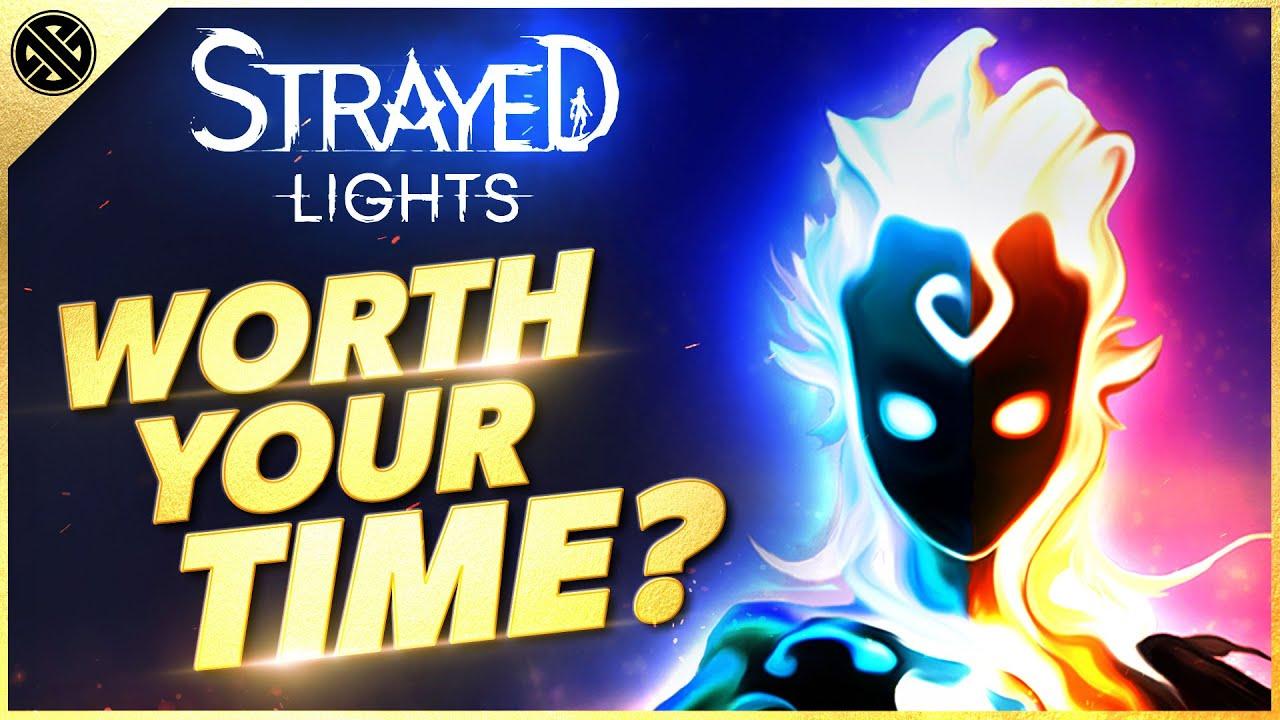Strayed Lights
Written by - Codiak
Updated: June 20, 2023
|
Posted: April 25, 2023

Before we begin, we want to send out a big thank you to the team over at Embers Studio for providing us with an early review copy of strayed lights. We’ve had this on our radar ever since it was first announced and we’ve been excited to go hands on. This title was revealed just over 2 months ago. The announcement was well received by fans of the genre, but after its initial buzz, it’s been lying low, flying under the radar, waiting for its time to shine.
Now let’s be clear upfront, is this game going to provide you with hours upon hours of playtime? No. In fact our playthrough only took about 3 hours in total. With a little more item hunting maybe you can squeeze out a 4 or 5 hours, but that’s a big maybe. Once complete, you don’t have save points to go back to, areas to explore further, or items to go hunt down to build out your whole skill tree. It’s a one and done type of game, and that’s perfectly fine because the team has never advertised it as anything else.
Strayed Lights is an atmospheric adventure. Think visuals, storytelling, and otherworldly audio cues. The game weaves a tale leaving you thinking about what just happened and what it means in the broader context of the story. Not in a confusing way mind you, rather it’s more about intrigue and mystery. I’ll be honest, I don’t play many games like this, so it took me a minute to wrap my head around what was going on. Once I figured that out, I started to get seriously wrapped up in the mystery of it all, and that’s really when the game grabs you in a good way.

Strayed Lights has no voice acting and relies on visual cues, character expressions, and musical moments to amplify ongoing events. You’re never told what’s going on. There’s no text dialog, no map, and no NPC guidance. As you play, you’ll peel back layers that help expand on the context of what you just experienced which adds to the overall mystery of what’s happening. It’s actually quite hard to review a game like this without revealing too much. You’re supposed to uncover what is going on for yourself and how it’s shaping the world around you. As players we might all have different emotional responses to the game, despite there being virtually no difference in the actual gameplay itself. This isn’t uncommon for game developers to do, putting players at the center of an emotional journey, but these types of games lean further into video games as an art form as compared to video games as a source of pure hack and slash entertainment.
COMBAT AND ENEMIES
So if the story and mystery are off limits what can we talk about? Well, we have some systems and as always we love focusing on the things that make games work in our reviews.
First let’s look at combat. This is very much based on a souls-like foundation. Enemies have very distinct attack patterns. With a basic parry and some slightly variable attacks, your job is to anticipate your enemy’s attack patterns and weave in your own attacks until they’re defeated, pretty standard stuff.

One thing that struck me as unique was the exceptional use of color to advertise enemy behaviors. Blue and orange attacks can be parried at all times, while purple cannot and you simply need to avoid the incoming damage. You yourself can switch color stances allowing you to match the incoming attack. If you parry with the wrong color, no harm done, you simply avoid the damage. However, matching your parry with the attack color will both do damage to the enemy and heal you for a small amount. But between parries and attacks, you’ll dwindle the health of enemies until defeated.
This mechanic is the main combat system throughout the entire game. In and of themselves, a single enemy’s attack pattern can be easily outmaneuvered. But as you progress, you’ll encounter more than 1 enemy with more complex movesets. Throw in a boss, and it’s a system that rewards mastery and punishes impatience.

I actually loved the visual simplicity but mechanical difficulty of some of the enemies. Remember, we’re only dealing with 3 colors for combat here, so you have to pay special attention to the look and feel of each enemy to understand what moveset you’re dealing with. The real challenge came when dealing with multiple enemies. You’re forced to try to isolate one target at a time, or if you’re feeling confident, use some of your special abilities to take out all enemies head on.
Bosses were the real standout in my opinion. Each one was completely unique both visually and mechanically. The team wove in elements of these larger encounters throughout each of the biomes, sprinkling in hints of what was to come. It was meant as both a carrot on a stick and a warning sign that you better master mechanics because soon things were coming to a head. Encounters were impactful, full of storytelling, and once defeated, really furthered the environmental storytelling of the game.
There were moments however during the boss encounters where you’d execute this super powerful attack to essentially end the fight. These moments were pure scripted cutscenes, again gorgeous, but had a couple of meaningless player engagement moments. As you were about to smack the boss into oblivion, you were prompted to hit a button. It was an unnecessary quick time event that didn’t actually help connect me to what was going on in the game, rather just something felt “slapped on” to create some false immersion.

PROGRESSION
So how does strayed lights handle player power or progression? After all, if you’re not getting stronger or changing your character in some way, that’s pretty boring. Well I’m happy to report the game does just enough to modify both power and abilities to make you feel like you’re getting stronger.
By defeating a boss and clearing a biome, you’ll gain a single token that can be used to learn up to 3 new abilities. Additional tokens past this really only serve to modify those 3 abilities with damage or duration buffs.
On the other side of the tree are enhancement nodes. These are simple modifiers that modify things such as increase your health, gain more healing when parrying, and increase your overall damage percentage. Currency for these are obtained after killing any world monster. Kill a monster, gain a token, and once you have enough, come back to the hub to spend it on an upgrade.

Let’s be clear, the skill tree is nothing revolutionary, it’s simple and effective. It doesn’t overly complicate your combat mechanics, rather compliments them. I did find myself using every ability regularly. Nothing felt wasted and what I invested in was impactful. Because the game is more about story, and less about endless character progression it’s not as big of a deal that the skill tree system is rather basic. In most cases we’d prefer something that really enhances our combat experience, but this game thrives on its simplicity, so it’s not a glaring concern.

To round out the experience you’ll collect floating orbs throughout each biome. Once you collect a set amount of these, you’ll unlock an increase to your overall energy reserves. Each tier you’ll be required to collect slightly more orbs than last time, and over time they really do add up. After obtaining a few of these, I was hopeful this would be a system that encourages exploration and potentially opened up some sort of puzzle or traversal elements, but the more I engaged with it the less excited I got finding each and every orb.
There was typically a single enemy guarding these. And oftentimes, you saw the orb from a distance and simply walked around a corner to go pick it up. All in all, this was a pretty big disappointment, mainly because it felt more like a chore than a system designed to spark any sort of meaningful moments in the game.
HANGUPS
While not terrible by any means, moving about the environment felt like it lacked polish. I often found myself getting stuck in animation when trying to jump to a ledge that wasn’t actually reachable. Almost like I was jumping through molasses. I’d just slowly slide down the side of the rock but couldn’t do anything until the animation finished.
I also felt moving around would have been way more fun with an extra movement skill such as a double jump. You move around a lot, often just running, and running, and running. There is a lot of empty space to navigate through and having something additional to get to ledges and jump over obstacles would have been more engaging. And to my previous point, this is where the team could have really executed some traversal puzzles to obtain those power orbs.
Finally, photo mode. While I appreciate a small studio adding this into the game it is super limited. You’re locked in to about a 10 meter range in all directions. I regularly found myself wanting to take a shot at some incredible distant landscape, only to hit an invisible ceiling or wall, which immediately pulled me out of the moment. Then I’d have to spend time trying to find a higher location to take the shot from, and often just settled for the shot I could get and moved on, never feeling satisfied that I got a great shot.
CONCLUSION
Truth is you’re not going to get dozens of hours out of this game. The combat isn’t complex, there’s no difficulty settings, and there’s no replayability. But the game doesn’t advertise any of that as something it brings to the table.
However, what strayed Lights does well is keep you immersed in the experience, the whole time. The pull from one minor story moment to the next was just enough to keep me wanting to play more and understand the world around me. Between the incredible visuals and the enjoyable, but simple combat, it was a playthrough I didn’t want to stop until I was finished. With that in mind, we say Strayed Lights is worth your time!






